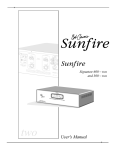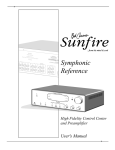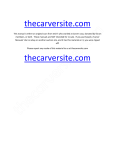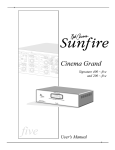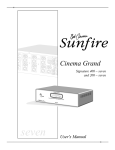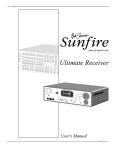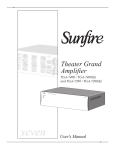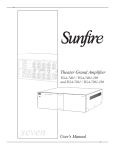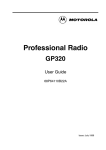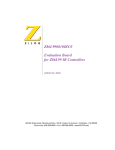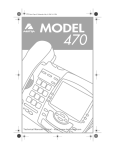Download Sunfire 913-047-00 Stereo Amplifier User Manual
Transcript
Symphonic Reference Load Invariant High Fidelity Stereo Power Amplifier SAFETY Safety Instructions 1. Read Instructions -– All the safety and operation instructions should be read before the SunÞre Component is operated. 2. Retain Instructions — The safety and operating instructions should be kept for future reference. 3. Heed Warnings — All warnings on the Component and in these operating instructions should be followed. 4. Follow Instructions — All operating and other instructions should be followed. 5. Water and Moisture — The Component should not be used near water - for example, near a bathtub, washbowl, kitchen sink, laundry tub, in a wet basement, or near a swimming pool, etc. 6. Ventilation — The Component should be situated so that its location or position does not interfere with its proper ventilation. For example, the Component should not be situated on a bed, sofa, rug, or similar surface that may block any ventilation openings; or placed in a built-in installation such as a bookcase, cabinet, or closed equipment rack that may impede the ßow of air through ventilation openings. 8. Power Sources — The Component should be connected to a power supply only of the type described in these operation instructions or as marked on the Component. 9. Power Cord Protection — Powersupply cords should be routed so that they are not likely to be walked upon or pinched by items placed upon or against them, paying particular attention to cords at plugs, convenience receptacles, and the point where they exit the Component. 10. Cleaning — The Component should be cleaned only as recommended in this manual. 11. Non-use Periods—The power cord of the Component should be unplugged from the outlet when unused for a long period of time. 12. Object and Liquid Entry — Care should be taken so that objects do not fall into and liquids are not spilled into the inside of the Component. 13. Damage Requiring Service — The Component should be serviced only by qualiÞed service personnel when: A. The power-supply cord or the plug has been damaged; or B. Objects have fallen, or liquid has spilled into the Component; or C. The Component has been exposed to rain; or D. The Component does not appear to operate normally or exhibits a marked change in performance; or E. The Component has been dropped, or its cabinet damaged. 14. Servicing — The user should not attempt to service the Component beyond those means described in this operating manual. All other servicing should be referred to qualiÞed service personnel. 7. Heat — The Component should be situated away from heat sources such as radiators, or other devices which produce heat. 2 User's Manual SAFETY 15. To prevent electric shock, do not use this polarized plug with an extension cord, receptacle or other outlet unless the blades can be fully inserted to prevent blade exposure. Pour préevenir les chocs électriques ne pas utiliser cette Þche polariseé avec un prolongateur, un prise de courant ou une autre sortie de courant, sauf si les lames peuvent être insérées à fond sans laisser aucune parIIIe à découvert. 16. Grounding or Polarization — Precautions should be taken so that the grounding or polarization means of the Component is not defeated. This apparatus does not exceed the Class A/Class B (whichever is applicable) limits for radio noise emissions from digital apparatus as set out in the radio interference regulations of the Canadian Department of Communications. ATTENTION — Le présent appareil numérique n'émet pas de bruits radioélectriques dépassant las limites applicables aux appareils numériques de class A/de class B (selon le cas) prescrites dans le règlement sur le brouillage radioélectrique édicté par les ministere des communications du Canada. WARNING – TO REDUCE THE RISK OF FIRE OR ELECTRIC SHOCK, DO NOT EXPOSE THIS APPLIANCE TO RAIN OR MOISTURE. CAUTION: TO PREVENT ELECTRIC SHOCK, MATCH WIDE BLADE OF PLUG TO WIDE SLOT, FULLY INSERT. ATTENTION: POUR ÉVITER LES CHOCS ÉLECTRIQUES, INTRODUIRE LA LAME LA PLUS LARGE DE LA FICHE DANS LA BORNE CORRESPONDANTE DE LA PRISE ET POUSSER JUSQU’AU FOND. Contents Safety Instructions................................... 2-3 Chapter 1: Introduction ...............................4 Unpacking and List of Features .................4 Overview.....................................................5 Rear Panel Features ..................................5 Installation ..................................................7 Chapter 2: System ConÞgurations .............8 Appendix: Series and Parallel ...................................11 Troubleshooting Guide .............................12 SpeciÞcations ...........................................14 Limited Warranty ......................................15 Service Assistance ...................................15 User's Manual Please read the Safety Instructions carefully before connecting and using your SunÞre AmpliÞer. Chapter 1 is a general introduction to the features, details and installation of your ampliÞer. Chapter 2 shows some typical connections to a preampliÞer and speakers. The Appendix shows some additional information, including a troubleshooting guide, the Warranty, and service assistance details. To Þnd out more about this and other SunÞre products, please visit our website: www.sunÞre.com 3 CHAPTER 1 Introduction Unpacking Dear Friend, Thank you for purchasing my SunÞre Symphonic Reference AmpliÞer. I hope that you enjoy it and the music it makes as much as I have enjoyed creating it for you. Features Your SunÞre AmpliÞer should reach you in perfect condition. If you do notice any shipping damage, please contact your SunÞre Dealer immediately. • Two channel Power AmpliÞer in a 17” wide chassis • 250 watts per channel into 8 ohms Gently lift out the unit and remove all the packing material and accessories. It is important to save all the packing materials and the box in case your ampliÞer ever needs to be moved or shipped for repair. • 500 watts per channel into 4 ohms • Outrageously low -115 dB Noise • An enormous power source provides the ultimate muscle for limitless dynamics • Peak-to-peak current output capability is 80 amperes per channel • The ampliÞer can drive almost any load to any rationally usable current or voltage level. • MOSFET tracking downconverter • 12 VDC trigger input for remote turn-on • The intrinsic frequency response extends from 1 Hz to beyond 100 kHz ___________________________ • IEC removable power cord ___________________________ • High quality styling and Þnish Make sure that you keep your sales receipt. It is the only way to establish the duration of your Limited Warranty and it may come in useful for insurance purposes. Please take a moment to Þll out and mail the SunÞre Customer Response card. Also read the serial number located on the rear panel and record it here: Serial #: ___________________________ Purchased at: ___________________________ ___________________________ Date: _______________________ 4 User's Manual CHAPTER 1 Overview Your SunÞre Symphonic Reference AmpliÞer is actually two highpowered ampliÞers combined in a 17 inch wide chassis. It accepts line-level signals from a controlling preampliÞer, and ampliÞes them to a higher speaker-level, suitable for driving powerful stereo and Home Theater speakers. Rear Panel Features 1 2 1. AUTO/ON/OFF Switch • In the ALWAYS-ON (up) position, the ampliÞer is always on, regardless of input signals or 12 VDC trigger. • In the ALWAYS-OFF (down) position, the ampliÞer is always off, regardless of input signals or 12 VDC trigger. Your SunÞre AmpliÞer is designed with an automatic on/off circuit. • In the AUTO-ON (center) position, the ampliÞer will automatically turn on if an audio signal is present at the left or right input, or if it receives an input trigger voltage at the 12 VDC inputs. The ampliÞer will automatically turn off after a few seconds if the trigger voltage is removed, or after approximately 20 minutes in the absence of an audio signal. User's Manual 2. 12 VDC Trigger Input Although the signal sensing turnon is adequate for most installations, the 12 VDC trigger inputs are offered as an optional way to turn on the ampliÞer. The SunÞre Symphonic Reference PreampliÞer has a compatible 12 VDC trigger output. When the preampliÞer is turned on, the ampliÞer will also turn on. 1/8" mono mini jacks are provided for ease of installation, along with a terminal strip to allow more ßexibility for custom-wired installations. The terminal strip and both the 1/8" mini jacks are connected in parallel, allowing 'daisy chaining' to turn on multiple ampliÞers. continued.. 5 CHAPTER 1 Rear Panel Features continued 3 4 3. RCA Unbalanced Inputs Your SunÞre AmpliÞer has three sets of inputs for each channel. Two are unbalanced RCA inputs and one is a balanced XLR type. The two RCA inputs for each channel are joined together internally and either one can be connected to the corresponding output of your preampliÞer. The other can be used as a daisy-chaining output, sending the preampliÞer output signal to another channel or to another ampliÞer. Note that signals cannot pass from the RCA into the XLR inputs. Do not drive the ampliÞer from more than one preampliÞer or other source. 3 4 5 4. XLR Balanced Inputs If your preampliÞer has XLR outputs, connect them to the XLR inputs. The female XLR inputs are wired as follows: Pin 1 is ground Pin 2 is positive (hot) Pin 3 is negative (cold) Balanced connections pass the input signal along two conductors. If there is any external noise and interference passing into the audio lines, both conductors will receive the same amount of noise. This noise is then rejected in the balanced input stage of the SunÞre AmpliÞer. 5. Outputs The top post of each pair is the positive output, and connects to the positive (red) post of your speaker. The bottom post of each pair is the negative, and connects to the negative (black) post of your speaker. The posts can accept bare wire, spade terminals, and dual or single banana connectors. 6 5 6 7 6. IEC Connector The ampliÞer comes with a detachable Linecord which attaches here. Make sure it is Þrmly pushed in place. Connect the other end to an AC outlet which is properly conÞgured for the type of plug and has the correct voltage for your model. 7. Line Fuse If this fuse fails, replace it with the exact same “Slow-Blow” type and current rating. Note: Always unplug the power cord from your AC outlet before removing the fuse. Use a ßat headed screwdriver, push in slightly and gently rotate the fuseholder half a turn. User's Manual CHAPTER 1 Installation Read and follow all safety instructions shown on pages 2 and 3. Observe the following precautions when choosing a location for your ampliÞer: • 12 VDC Trigger Before setting up your new system, please consider the following : If you have a Symphonic Reference PreampliÞer, it has a Trigger terminal which supplies 12 VDC whenever the preampliÞer is turned on. This voltage can be used to turn on the ampliÞer. Always make sure that your components are all turned OFF, or unplugged before making or changing any connections. Do not cover any of the ventilation slots on the bottom or sides. • Do not place a preampliÞer directly on top of the power ampliÞer. • Protect it from prolonged exposure to direct sunlight and other direct sources of heat, such as heating vents and radiators. • Connection Tips Do not expose the unit to rain or moisture. If ßuid or a foreign object should enter the unit, immediately turn off the power and contact your SunÞre Dealer. • Avoid excessive exposure to extreme cold or dust. • Do not place heavy objects on top of the unit. • • • Make sure that the power cords of all your components are attached to the same outlet or at least to the same circuit. This will reduce the possibility of a ground loop in the system. Make sure that the total current draw does not exceed the current rating of the outlet. Use the XLR inputs if your preampliÞer has XLR outputs. These balanced connections provide superior noise rejection. • Whenever possible, route the power cords away from the signal cables or speaker wires to prevent any hum or interference heard in the speakers. AC Power Considerations • Ensure that the unit is plugged into an outlet capable of supplying the correct voltage speciÞed for your model. The outlet should be capable of supplying 15 amps at 120V. Choose reliable hookup cables. They should be fully shielded and as short as possible. • Some patch cords can be a very tight Þt and there is usually a preferred method of getting them off. Some have to be removed with a twisting action. Be gentle or you may damage the jacks of your ampliÞer, or other components. • Some audiophile cables should be hooked up in one direction, these are usually marked with arrows. • It is usual for the right channel patch cord plugs to be red and the left channel connections to be white, grey or black. Care If you need to clean the front surface, Þrst turn unplug the power cord from the AC supply, and then use a dry cloth, rubbing with the grain. Be careful not to scratch the Þnish. Avoid strong cleaning agents. User's Manual Use all standard safety precautions and make sure all the equipment is disconnected before making any connections. Any 1/8" mono to mono (two-wire) interconnect cable will sufÞce to connect the 12 V trigger output from the preampliÞer to the ampliÞer. The voltage range for the ampliÞer's trigger input is 5 to 18 Volts DC. Do not exceed 18 Volts on this input. (CAUTION: Do not connect AC line voltage to this input!) The input impedance of the 12 V trigger input is approximately 600Ω (20 mA @ 12 V). 7 CHAPTER 2 System ConÞgurations The following diagrams show some typical connections that you might make in your installation. They show how the inputs and outputs of the SunÞre AmpliÞer are connected to your preampliÞer and speakers. Connections to the SunÞre Symphonic Reference PreampliÞer Line-level audio signals From: PreampliÞer main outputs To: AmpliÞer line-level inputs 12 VDC Trigger voltage From: PreampliÞer 12 VDC trigger outputs To: AmpliÞer 12 VDC trigger inputs + - RIGHT SPEAKER Speaker-level audio outputs From: AmpliÞer outputs To: Speaker input posts 8 + - LEFT SPEAKER The ampliÞer's line-level audio inputs can be connected to the SunÞre Symphonic Reference PreampliÞer as shown. The ampliÞer will boost the preampliÞer's output, up to a level suitable for driving speakers. The 12 VDC connection shown, can be used to turn the ampliÞer on when the preampliÞer turns on. Alternatively, you could use the ampliÞer's AUTO-ON switch. The ampliÞer will then automatically turn on when a preamp signal is received. User's Manual CHAPTER 2 Balanced Connections PREAMPL IFIER BALANCED OUTPUTS RIGHT LEFT Balanced line-level audio signals From: PreampliÞer XLR outputs To: AmpliÞer XLR inputs + - RIGHT SPEAKER + - LEFT SPEAKER If your preampliÞer has XLR balanced outputs, it can be connected to the ampliÞer's XLR inputs as shown. Speaker-level audio outputs From: AmpliÞer outputs To: Speaker input posts User's Manual 9 CHAPTER 2 Biamping connections If your speakers can be biamped, they will have separate input posts for the woofer and the tweeter sections. This diagram shows how to create a very efÞcient system with an active external crossover. The crossover will split the incoming preamp signal into two frequency ranges: one above and one below the crossover frequency. True biamping is very efÞcient because each ampliÞer channel only receives and ampliÞes the range required for its driver. For example, in the diagram below, the right channel only ampliÞes the low frequencies, and the left channel only ampliÞes the high frequencies. Make sure that you adjust the crossover frequency to suit your speaker's crossover point. Check the speaker owner's manual for this speciÞcation. An alternative connection method is to have one ampliÞer running the two woofers and the other running the two tweeters. This is useful if your ampliÞers have different power ratings. Use the more powerful ampliÞer to run the woofers. PREAMPLIFIER BALANCED OUTPUTS RIGHT RIGHT INPUT LOW HIGH R OUTPU TS LEFT LEFT INPUT LOW HIGH ACTIVE EXTERNAL CROSSOVER L OUTPUT S HIGH LOW TO SECOND AMPLIFIER + - RIGHT WOOFER 10 + - RIGHT TWEETER User's Manual APPENDIX Series and Parallel speaker connections The connection of more than one speaker per channel will tend to degrade the speaker’s frequency response, and may make the ampliÞer run hot. For the best results use one speaker per channel. Parallel For example, if you want to parallel-connect two speakers to the front right channel of the ampliÞer: If you do want to connect more than one speaker per channel, there are two main ways: Series or Parallel. Series For example, if you want to series-connect two speakers to the front right channel of the ampliÞer: Amplifier Outputs • The positive output terminal of the right channel connects to the positive input post of the Þrst speaker and to the positive post of the second speaker. • The negative output terminal of the right channel connects to the negative input post of the Þrst speaker and to the negative post of the second speaker. • The total impedance of equal speakers in parallel is found by dividing the impedance of one speaker by the number of speakers. For example, two eight ohm speakers in parallel is a four ohm load (eight ohms divided by two), four eight ohm speakers in parallel is a two ohm load (eight ohms divided by four). • Parallel connections are harder on the ampliÞer than series connections, as the total impedance is lower compared to driving a single speaker, and the ampliÞer must produce more current to drive them. Amplifier Outputs • The positive output terminal of the right channel connects to the positive input post of the Þrst speaker. • The negative input post of the Þrst speaker connects to the positive input post of the second speaker. • The negative input post of the second speaker connects to the negative output terminal of the right channel. • The total impedance of speakers in series is found by adding their impedances together. For example, two four ohm speakers in series is an eight ohm load. • Series connections are easier on the ampliÞer than parallel connections as the total impedance is higher than driving a single speaker. User's Manual • Ideally, the total average impedance should be no less than 2 ohms per channel. • You must make sure that the lower impedance does not cause the ampliÞer to overheat, shut down, blow the line fuse, or pop your circuit breaker. If this happens, you should reduce the number of speakers wired in parallel, rewire them in series, or use more than one power ampliÞer. 11 APPENDIX Troubleshooting Guide The SunÞre AmpliÞer is expertly designed and built to provide years of trouble-free performance. Most problems that occur can usually be solved by checking your setup or making sure that the audio and video components connected to the processor are on and fully operational. The following information will help you deal with common setup problems you may experience during normal use of your unit. If the problems still persist, please contact your SunÞre Dealer for assistance. No sound from one or more speakers • Speaker cables may have come undone. Turn off your system and check the cables, and tighten the ampliÞer and speaker binding posts. • Broken audio cable. • The preampliÞer balance level is low for the channel concerned. • The preampliÞer Mute switch is on, or an external processor loop or a tape monitor loop is engaged. • • If you have connected speakers in Parallel, the overall impedance may be too low. It is recommended that you rearrange the speakers in Series to increase the overall impedance, thus taking some of the load off the ampliÞer. Make sure that the ampliÞer has good ventilation and is not overheating. If the ampliÞer is in a closed rack, open up the rear panel or use a quiet fan for improved ventilation. A Hum is heard in your speakers This problem is more than likely caused by a “ground loop” in your system, rather than a fault in the ampliÞer. Follow these steps to isolate the main cause of the hum, there may even be more than one. • • The ampliÞer shuts down often or the line fuse blows often • • Check that the positive and negative speaker wires are not shorted together. Make sure that no speakers are shorted internally. If you have an ohm-meter, disconnect the speaker wires and measure the resistance between the speaker’s positive and negative terminals. If the reading is less than 2 ohms, the speakers may have an internal short. Measure all speakers and check their impedance speciÞcations. 12 • Remember to turn off all components in your system, including the ampliÞer, before disconnecting or connecting any cables. Disconnect all cables which come from outside the room, and check if the hum goes away. This includes such connections as cable TV, satellite TV, or roof top antennas. Make sure that they are disconnected where they Þrst enter the room, so they are making no connection to the preampliÞer or the TV, or any other component. If the hum is caused by the cable TV line, then you will need a “ground loop isolator.” This is an inexpensive device Þtted in line with the coaxial cable feed. Contact your cable company or your SunÞre Dealer for assistance. Disconnect all connections from the preampliÞer to your TV, VCR or DVD. • Disconnect any component which has a grounded power cord. • If the hum persists, disconnect all the source components one at a time from the back of the preampliÞer, until you identify the problem. • Ground loop isolators are available for audio lines and video. You can ask your SunÞre Dealer for assistance. • Try moving the speaker cables away from any power cords. Try just one speaker, connecting it to each ampliÞer channel and see if one channel is bad. • If you are still having a problem, remember that SunÞre’s dealers and technical support staff will assist you. Other causes of noise • Speaker noise may also be caused by interference or noise on your AC line. Make sure there are no large appliances sharing the line, or halogen lamps or light-dimming Triac devices. • Try connecting your system to another AC socket on a separate line. • Keep power cords away from audio cables. • Do not place the preampliÞer directly on top of the ampliÞer. • If the hum is heard from within the ampliÞer and not through the speakers, this may also be caused by interference on the AC or DC lines. The power transformers may turn this interference into an audible noise. Internal hum can be made worse by a shelf or cabinet resonating, so try moving the ampliÞer to another shelf. User's Manual APPENDIX • Try moving your components further away from the TV, especially if you ever notice the screen has changed color in the area closest to the component. • If you have very high efÞciency speakers, these may show up noise which other speakers may not. Poor bass performance • Make sure that your preamp does not have the bass level turned down. • Many surround preampliÞers have controls which can direct all the bass to subwoofers, or let your main speakers play the full range. Make sure that the preampliÞer has been correctly set. • Check that the speaker wires have been connected correctly: Make sure that the positive of each speaker connects to a positive output of the ampliÞer, and the negative of each speaker connects to a negative output. If one speaker is wired incorrectly, than it will be “out of phase” with the others, resulting in poor bass performance. • If you have connected the ampliÞer using the XLR inputs, make sure that the XLR cables are wired correctly. If one has the hot and cold reversed, then this will also cause a speaker to be out of phase. Turn-on and turn-off thumps • Plug the ampliÞer into an unswitched AC outlet, and use the AUTO-ON feature. This will allow the ampliÞer to turn on and off with good manners. User's Manual 13 APPENDIX SpeciÞcations Power output 250 watts continuous, per channel, all channels driven into eight ohms, from 20 Hz to 20 kHz with no more than 0.5% T.H.D. Power at clipping, minimum: 500 watts per channel into four ohms. Hum and Noise -115 dB, A-Weighted Maximum output current 80 amperes peak to peak per channel Maximum output voltage Power Consumption 45 W at idle 200 W typical (1/8th power) 1800 W absolute maximum (fuse limit) Dimensions 17.0 inches wide 5.75 inches high (with feet) 16.5 inches deep (to tips of connectors) Weight 30 lbs Finish Brushed aluminum and black anodize 45 Vrms Input impedance, RCA inputs 24 kΩ Input sensitivity for rated output Unbalanced: 1.6 Vrms Balanced: 0.8 Vrms Input impedance,XLR input 24 kΩ, each leg balanced to ground Female XLR Pin 1 ground Pin 2 positive (hot) Pin 3 negative (cold) 12 VDC Trigger Inputs Input voltage range 5 VDC-18 VDC Input impedance Approximately 600 Ω (20 mA at 12 V) Removable terminal block Dual 1/8” minijacks for daisychaining © 2002 SunÞre Corporation. All rights reserved. SunÞre Corporation reserves the right to improve its products at any time. Therefore, speciÞcations are subject to change without notice. Manual part number: 913-047-00 Rev A 14 User's Manual APPENDIX Limited Warranty SunÞre Corporation is proud of its products which have been built with care using advanced technology and premium component parts. Your unit has been crafted to perform properly for many years. SunÞre Corporation offers the following Warranty to you, the owner of a new SunÞre product: The SunÞre Corporation Warranty for the Symphonic Reference AmpliÞer is in effect for FIVE years from the date of original retail purchase. The SunÞre Corporation Warranty covers defects in materials and workmanship. The following, however, are excluded: a) Damage caused during shipment. b) Damage caused by accident, misuse, abuse of operation contrary to the instructions speciÞed in the SunÞre Corporation user’s manual. c) Units where the serial number has been defaced, modiÞed or removed. d) Damage resulting from modiÞcation or attempted repair by any person not authorized in writing by SunÞre Corporation. e) Units purchased from unauthorized dealers. The SunÞre Corporation Warranty extends to the original owner or subsequent owner(s) during the Þve year warranty period, so long as the original dated purchase receipt is presented whenever warranty service is required. Service Assistance SunÞre Corporation’s liability is limited to the repair or replacement, at our option, of any defective product and shall not in any event include property or any other incidental or consequential damages which may result from the failure of this product. Some states do not allow limitations on how long an implied warranty lasts and/or do not allow the exclusion or limitation of incidental or consequential damages, so the above limitations or exclusions may not apply to you. This Warranty gives you speciÞc legal rights, and you may also have other rights which vary from state to state. We suggest that you attach your purchase receipt to this Warranty and keep these in a safe place. Thank you for your choice of a SunÞre Corporation product. We suggest that you read the Limited Warranty completely to fully understand your Warranty/Service coverage. If your SunÞre Corporation product ever requires service, write to us or call: SunÞre Corporation Technical Services Department P.O. Box 1589 Snohomish, WA 98291 Tel (425) 335-4748 Fax (425) 335-4746 You will be directed to an authorized SunÞre Corporation Service Station or receive instructions to ship the unit to the factory. Please save the original shipping carton and packing materials in case shipping is required. Please do not ship Parcel Post. NOTE: Before sending in your unit for repair, you must call SunÞre for return authorization. Include a complete description of the problem, indicating how you have it connected, the associated equipment in your system and a copy of your purchase receipt. Initial shipping costs are not paid by SunÞre Corporation; return ground shipping costs will be prepaid if repairs were covered by the scope of this Warranty. All implied warranties, including warranties or merchantability and Þtness for particular purposes, are limited in duration to the two year length of this Warranty, unless otherwise provided by state law. User's Manual 15 Symphonic Reference Load Invariant High Fidelity Stereo Power Amplifier Manual part number : 913-047-00 Rev A
















